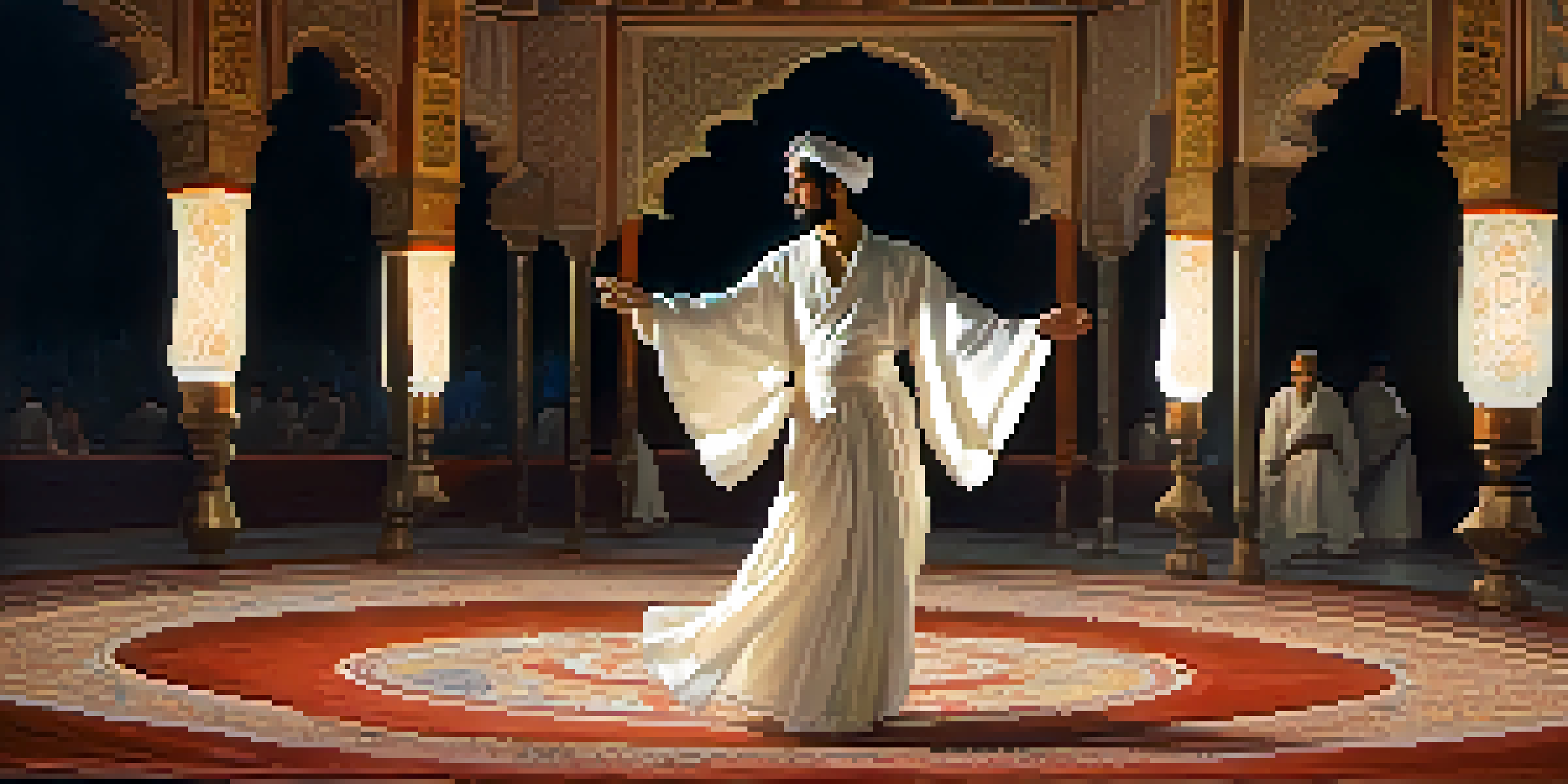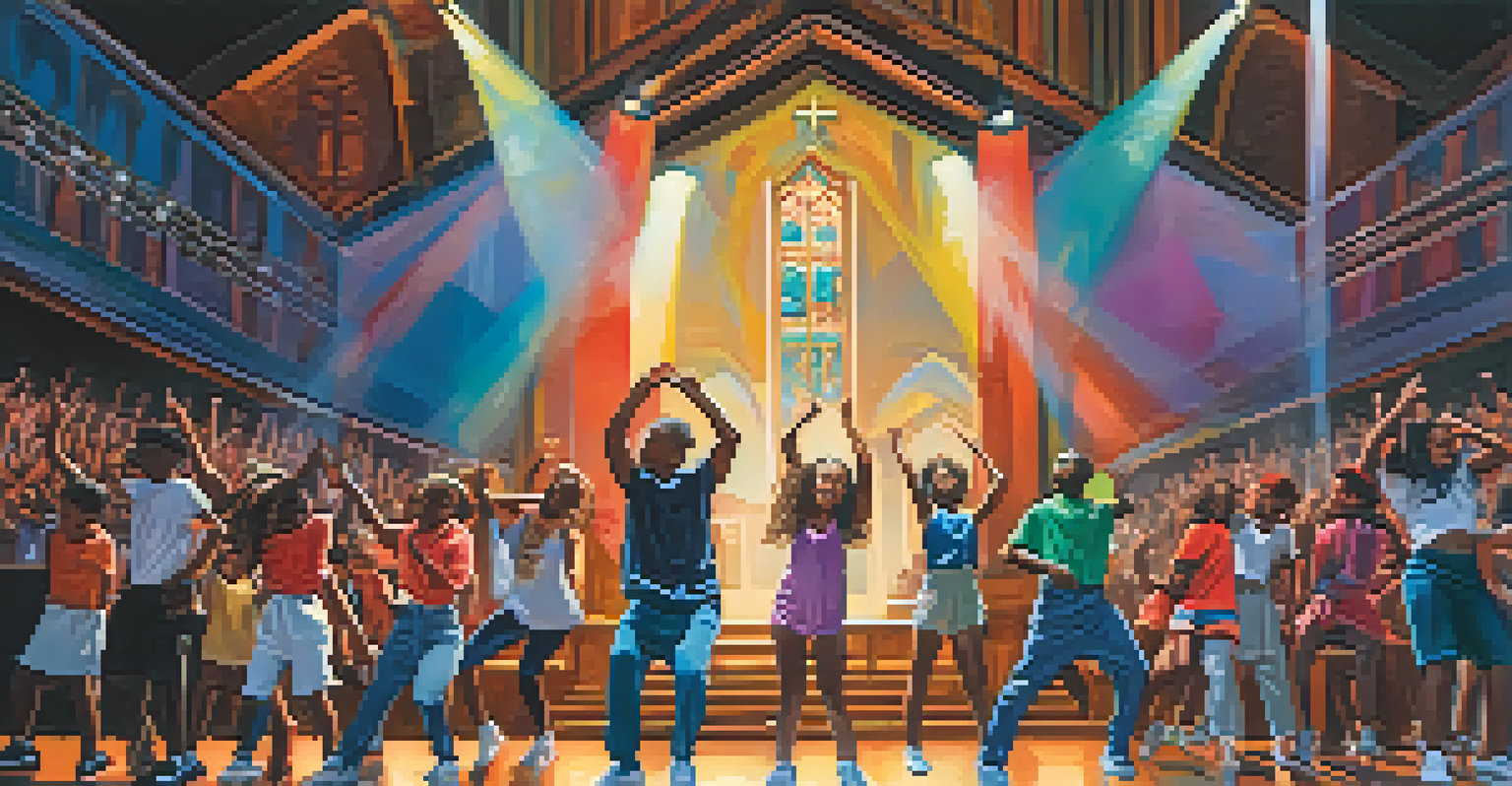Exploring the Symbolism of Dance in Religious Rituals

The Historical Roots of Dance in Religious Practices
Dance has been an integral part of religious rituals since ancient times. Cultures around the world have used movement as a form of worship, celebrating deities and connecting with the divine. For instance, the ancient Greeks performed dances to honor their gods, while indigenous tribes often danced to celebrate harvests or rites of passage.
The body says what words cannot.
These early forms of dance were more than just entertainment; they served as a medium for storytelling and communal bonding. Through movement, participants expressed their beliefs and emotions, creating a shared experience that strengthened their faith. This deep-rooted connection between dance and spirituality continues to resonate in modern practices.
Today, many religions still incorporate dance into their rituals, showcasing its enduring significance. From the spirited Sufi whirling to the graceful movements of ballet in religious performances, dance remains a powerful conduit for spiritual expression.
Dance as a Form of Spiritual Expression
In many religious contexts, dance transcends mere physical movement; it becomes a language of the soul. Participants often describe feelings of transcendence or connection to a higher power during these rituals. For example, in African tribal ceremonies, dancers enter a trance-like state, believed to facilitate communication with ancestors and spirits.

This spiritual aspect of dance allows individuals to express emotions that words sometimes fail to capture. Joy, sorrow, gratitude, and devotion can all be articulated through movement, creating a visceral experience for both the dancer and the observer. It’s a form of worship that connects the body, mind, and spirit.
Dance as Spiritual Expression
Dance serves as a profound language of the soul, allowing participants to express emotions and connect with the divine during religious rituals.
Moreover, the communal nature of dance in religious settings fosters unity among participants. As individuals come together in shared movement, they form a collective identity that reinforces their faith and community bonds.
Symbolism of Movement in Religious Dance
Movement in dance often carries deep symbolism, representing various spiritual concepts. For instance, the circular motion in many dances symbolizes eternity or the cyclical nature of life and death. This is evident in the traditional Hindu dance forms that often depict mythological stories, illustrating the dance of creation and destruction.
Dance is the hidden language of the soul.
Similarly, gestures and steps can convey specific meanings, such as offering, reverence, or celebration. In Christian liturgical dance, movements may symbolize praise and adoration, creating a visual representation of worship. This rich symbolism adds layers of meaning to the dance, making it a profound part of the ritual.
Through these symbolic movements, dancers can invoke spiritual themes, making the experience resonate on a deeper level. This connection between movement and meaning enriches the ritual, allowing participants to engage more fully with their spirituality.
Cultural Variations in Dance Rituals
Across different cultures, the role and style of dance in religious rituals can vary significantly. For instance, the vibrant samba in Brazilian Candomblé ceremonies contrasts sharply with the solemnity of the Jewish hora during wedding celebrations. Each dance reflects the unique cultural context and beliefs surrounding the ritual.
In some Native American traditions, dance is seen as a way to honor nature and the spirits of the land. The powwow, for example, features various dances that celebrate history, community, and identity. These cultural expressions are intertwined with the spiritual, highlighting the diverse ways dance can manifest in religious practices.
Cultural Variations in Dance
Different cultures showcase unique dance styles in religious practices, reflecting their distinct beliefs while maintaining dance's universal role in worship.
Despite these variations, the core essence of dance as a form of worship remains consistent. Whether through joyous celebration or solemn reverence, dance serves as a universal language that transcends cultural boundaries.
The Role of Music in Religious Dance
Music and dance are often inseparable in religious rituals, working together to create a powerful atmosphere. The rhythm of drums, chants, or melodies can guide the movements of dancers, enhancing the spiritual experience. In many African and Caribbean traditions, the heartbeat of the drum is considered a connection to the divine.
Furthermore, the choice of music can evoke specific emotions, setting the tone for the ritual. For example, uplifting melodies might accompany celebratory dances, while slower, more somber tunes may align with reflective movements. This synergy between music and dance helps participants immerse themselves in the spiritual experience.
As dancers respond to the music, they create a dynamic interaction that further enriches the ritual. This partnership creates a holistic environment where the body, sound, and spirit unite, deepening the overall impact of the dance.
The Transformative Power of Dance in Rituals
Dance has the remarkable ability to transform both individuals and communities during religious rituals. Participants often report feelings of liberation and emotional release, making dance a therapeutic outlet. This transformative effect can be especially profound in healing ceremonies, where dance is used to restore balance and harmony within the individual and the community.
Moreover, witnessing a dance ritual can inspire observers, evoking a sense of connection and reverence. The energy generated by the dancers can uplift the entire congregation, fostering a communal spirit of worship. This shared experience can lead to deeper connections among participants, reinforcing their spiritual beliefs and communal ties.
Future of Dance in Rituals
As communities evolve, dance in religious contexts will likely continue to adapt, merging traditional and modern styles to enhance spiritual expression.
Through its ability to transcend language and cultural barriers, dance becomes a universal expression of spirituality. Whether in a small gathering or a large celebration, the transformative power of dance enriches the ritual experience for everyone involved.
Modern Interpretations of Dance in Religious Contexts
In our contemporary world, dance continues to evolve within religious contexts, often merging traditional forms with modern styles. Many religious leaders and communities are embracing these innovations, recognizing the relevance of dance in today's society. This fusion can be seen in various faiths, where hip-hop or contemporary styles are incorporated into worship services.
These modern interpretations often aim to attract younger generations, making spirituality more accessible and relatable. By blending traditional elements with contemporary expression, dance becomes a living tradition that resonates with today’s believers. This evolution doesn’t diminish the ritual's significance; rather, it enhances its relevance in a rapidly changing world.

As communities adapt their dance practices, the core purpose remains—connecting with the divine and expressing spirituality. This ongoing dialogue between tradition and innovation reflects the dynamic nature of faith and the enduring power of dance.
The Future of Dance in Religious Rituals
Looking ahead, the future of dance in religious rituals appears promising, with continued exploration and integration of diverse styles. As globalization connects cultures, we may see an even richer tapestry of dance forms being incorporated into various religious practices. This could lead to exciting new interpretations and expressions of spirituality.
Moreover, as society becomes more inclusive, there may be greater emphasis on the role of dance in fostering community and belonging. Dance can serve as a bridge, connecting people across different backgrounds and beliefs, promoting understanding and unity. This potential for dance to act as a unifying force within and across faith communities is both exciting and necessary.
Ultimately, the future of dance in religious rituals will likely reflect the evolving nature of spirituality itself. As communities continue to seek connection and meaning, dance will remain a vital expression of faith, capable of adapting and resonating with the ever-changing human experience.